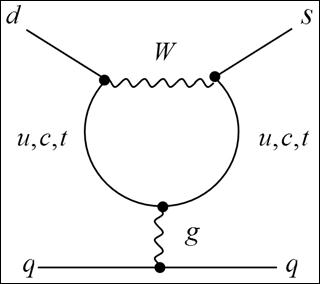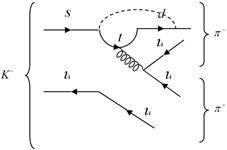| 1. | ||
| 2. | ||
| 3. | ||
| 4. | ||
| 5. | ||
K Meson Decays in Quark Model
Kh. Ghasemi1, N. Ghahramany2, H. Mehraban1
1Islamic Azad University, Central Tehran Branch, Tehran, Iran
2Islamic Azad University, Arsanjan Branch, Arsanjan, Iran
Email address
 (N. Ghahramany)
(N. Ghahramany) Citation
Kh. Ghasemi, N. Ghahramany, H. Mehraban. K Meson Decays in Quark Model. International Journal of Modern Physics and Application. Vol. 3, No. 3, 2016, pp. 45-51.
Abstract
In this paper, the decay of ![]() mesons have been studied by means of the Effective Hamiltonian Theory. Decay rates of the constituent S and
mesons have been studied by means of the Effective Hamiltonian Theory. Decay rates of the constituent S and ![]() quarks, in the tree and penguin levels are calculated via effective Lagrangian density of the weak interaction and then by using these obtained decay rates, the decay rates and branching ratios of K and
quarks, in the tree and penguin levels are calculated via effective Lagrangian density of the weak interaction and then by using these obtained decay rates, the decay rates and branching ratios of K and ![]() are calculated and compared with the experimental results. Findings from this study are in a good agreement with the experimental values.
are calculated and compared with the experimental results. Findings from this study are in a good agreement with the experimental values.
Keywords
K Meson, Quark Model, Effective Hamiltonian, Branching Ratio, Decay Rate
1. Introduction
One of the successful models in particle phenomenology is the quark model which is applied to calculate the decay rates of various particles. The particles called kaons, were first observed in late 1940s in cosmic-ray experiments. By today’s standards, they are common, easily produced, and well understood. Over the last four decades, studies on how kaons decay have played a major role in development of the Standard Model. Yet, after all this time, kaon decays may still prove to be a valuable source of new information on some of the remaining fundamental questions in particle physics.
When first observed, kaons seemed quite mysterious. Experiments showed that they were produced in reactions involving the strong force, or strong interaction – the most powerful of the four fundamental forces in nature – but they did not decay (that is, transform into two or more less massive particles) through the strong interaction. This is due to kaons retaining a feature which ultimately labeled "strangeness," that is conserved in the strong interaction [1].
One of the most interesting and unique observed particles in the nature is kaon. There are two neutral kaons which are, in fact, strange mesons.
 (1-1)
(1-1)
![]() is the eigenvalue of the strange state. Since each kaon under CP effect turns into another kaon, neither of these kaons have determined CP number.
is the eigenvalue of the strange state. Since each kaon under CP effect turns into another kaon, neither of these kaons have determined CP number. ![]() and
and ![]() are not eigenstate of CP. However, when CP acts on them, they are conjugate of each other.
are not eigenstate of CP. However, when CP acts on them, they are conjugate of each other.
 (1-2)
(1-2)
But theorists can make a pair kaon with determined CP from combination of wave
function ![]() and
and ![]() . According to Quantum Mechanics rules, these combinations correspond with real particles and have a mass and determined lifetime. Therefore normalized eigenstate CP are [2, 14]:
. According to Quantum Mechanics rules, these combinations correspond with real particles and have a mass and determined lifetime. Therefore normalized eigenstate CP are [2, 14]:
 (1-3)
(1-3)
So,
 (1-4)
(1-4)
![]() can just decays to
can just decays to ![]() state, while
state, while ![]() should go to
should go to ![]() state. Neutral kaons usually decay to two or three pions. Arrangement of two pions has +1 parity and three pions system has -1 parity and both of them have a
state. Neutral kaons usually decay to two or three pions. Arrangement of two pions has +1 parity and three pions system has -1 parity and both of them have a![]() . As a result,
. As a result, ![]() decays to two pions and
decays to two pions and ![]() decays to three pions [3].
decays to three pions [3].
![]() (1-5)
(1-5)
Since a kaon has hardly enough mass to produce three pions, two pion decays are fast but three pion decays are longer. Observed lifetimes are about ![]() and
and![]() , respectively [2, 10].
, respectively [2, 10].
![]() meson decay, as a weak decay, in the presence of strong interactions requires a special approach. The main tool to investigate these decays is the effective Hamiltonian Theory. Beginning of any phenomenological weak decay of hadrons is the effective weak Hamiltonian. Its structure is as follows:
meson decay, as a weak decay, in the presence of strong interactions requires a special approach. The main tool to investigate these decays is the effective Hamiltonian Theory. Beginning of any phenomenological weak decay of hadrons is the effective weak Hamiltonian. Its structure is as follows:
![]() (1-6)
(1-6)
Where ![]() is the Fermi constant represented in terms of the
is the Fermi constant represented in terms of the ![]() weak coupling constant and
weak coupling constant and ![]() boson mass is defined as follows:
boson mass is defined as follows:
=![]() (1-7)
(1-7)
And ![]() are the local operators which control the decay.
are the local operators which control the decay. ![]() , the Cabibbo–Kobayashi–Maskawa factors and
, the Cabibbo–Kobayashi–Maskawa factors and ![]() , the Wilson Coefficients are described by the force with which an operator enters the Hamiltonian. In fact, the effective point-like vertices are represented by local operators that can correct the picture of the decay of hadrons with a mass of the order of
, the Wilson Coefficients are described by the force with which an operator enters the Hamiltonian. In fact, the effective point-like vertices are represented by local operators that can correct the picture of the decay of hadrons with a mass of the order of ![]() a better way to provide.
a better way to provide. ![]() The Wilson coefficients to be used as coupling constants (depending on scale) corresponding to the vertices are taken into account. Selection of the
The Wilson coefficients to be used as coupling constants (depending on scale) corresponding to the vertices are taken into account. Selection of the ![]() scale is optional, but it is customary to choose
scale is optional, but it is customary to choose ![]() from the order of the mass of hadrons decaying, e.g for
from the order of the mass of hadrons decaying, e.g for![]() and
and![]() mesons decay, the value of
mesons decay, the value of ![]() are in the order of
are in the order of ![]() and
and ![]() , respectively. For kaon decays, the common choice of
, respectively. For kaon decays, the common choice of ![]() is in the order of
is in the order of ![]() instead of
instead of ![]() order [4].
order [4].
2. Calculation of ![]() Decay Rates in the Tree Level
Decay Rates in the Tree Level
The standard model can be used for those particle decays in which their non- perturbative aspects, mainly do not affect the decay process. In fact here, the modes of S quark decays are studied which have not entered the QCD area and take place by bosons. This area is called the tree level [2].
Effective Lagrangian density related to the weak interaction could be expressed in terms of the coupling of the weak currents. Since the ![]() decays through
decays through ![]() particle in tree level is being investigated here, the weak currents in Lagrangian, the charged currents and Effective Lagrangian density, could be described as following [5, 6]:
particle in tree level is being investigated here, the weak currents in Lagrangian, the charged currents and Effective Lagrangian density, could be described as following [5, 6]:
![]() (2-1)
(2-1)
Assuming that the wave functions of particle and antiparticle are normalized in ![]() volume, with the coefficient of normalization of
volume, with the coefficient of normalization of ![]() , and assuming that the
, and assuming that the ![]() quark is at rest (
quark is at rest (![]() ), the currents in above equation is given as follow:
), the currents in above equation is given as follow:
 (2-2)
(2-2)
Here ![]() , so
, so![]() ,
, ![]() that
that ![]() are the Pauli
are the Pauli ![]() matrices, also
matrices, also ![]() is the identity matrix. Furthermore,
is the identity matrix. Furthermore, ![]() and
and ![]() are the elements of the
are the elements of the ![]() matrix. Assuming
matrix. Assuming ![]() (quark's momentum in x-z plane) the positive and negative helicity of the quarks could be expressed as follows:
(quark's momentum in x-z plane) the positive and negative helicity of the quarks could be expressed as follows:
 (2-3)
(2-3)
According to the Perturbation Theory, the decay matrix element in the lowest-order is [7]:
![]() (2-4)
(2-4)
However, substituting ![]() in Eq. (2-4), then:
in Eq. (2-4), then:
![]() (2-5)
(2-5)
In which with considering relations of quarks speed, ![]() is defined:
is defined:
 (2-6)
(2-6)
Now in order to calculate the decay amplitude, the ![]() components for
components for![]() and over the quark spin states
and over the quark spin states ![]() and
and![]() , are found. The spin average sentence is:
, are found. The spin average sentence is:
![]() (2-7)
(2-7)
The above relation is obtained for final quarks in![]() ) helicity state. There are 8 helicity states. All of the helicity states are summed.
) helicity state. There are 8 helicity states. All of the helicity states are summed.
![]() (2-8)
(2-8)
The decay rate is:
![]() (2-9)
(2-9)
Where,
![]() and
and ![]() .
.
With considering that the angle between velocity of particles must be physical, ![]() , in that result:
, in that result:

 (2-10)
(2-10)
If Eq. (2-5) is substituted in Eq. (2-9) and perform the calculations, then:
![]() (2-11)
(2-11)
Where ![]() is the phase space integral and
is the phase space integral and ![]() .
.
The important point here is that it is assumed, the color factor to be 3 for Hadron decays. The decay rate for semi-lepton decays (assuming that the matrix elements of the lepton vertices are considered to be equal to 1) and the Hadron decays are:
![]() (2-12)
(2-12)
![]() (2-13)
(2-13)
Table 1 presents the decay rate with corresponding errors in tree level for several numbers of semi-lepton and hadron decays of S quark, respectively, by using Eqs (2-12) and (2-13). The sources of errors correspond to quark mass data taken from [9].

Table 1. ![]() Quark Decay Rate in Tree level.
Quark Decay Rate in Tree level.
| Decay Process | |
|
|
|
|
|
|
|
|
|
|
|
|
|
|
|
|
|
|
3. Calculation of the ![]() Decay Rates in Tree and Penguin Levels
Decay Rates in Tree and Penguin Levels
In the standard model, Flavor Changing Neutral Current (![]() ) is prohibited. For example, there is no direct coupling between the
) is prohibited. For example, there is no direct coupling between the ![]() quark and the
quark and the ![]() and
and ![]() quarks. In fact, at the vertices of the
quarks. In fact, at the vertices of the ![]() ،
، ![]() and
and ![]() neutral boson, the quark flavors do not change. This fact indicates the absence of
neutral boson, the quark flavors do not change. This fact indicates the absence of ![]() currents in the tree level.
currents in the tree level.
![]() vertices could be used in building up the desired structure of the loops. In another words,
vertices could be used in building up the desired structure of the loops. In another words, ![]() currents are created by penguin or one-loop diagrams. A penguin diagram and the schema of the Penguin are presented in Figure 1:
currents are created by penguin or one-loop diagrams. A penguin diagram and the schema of the Penguin are presented in Figure 1:

Figure 1. Penguin level.
As it could be observed in Figure 1, one loop is created. In fact, in this loop, for example, a ![]() boson is emitted during the
boson is emitted during the ![]() decay, while
decay, while ![]() quark is converted to the
quark is converted to the ![]() internal quark. Then the boson is absorbed and
internal quark. Then the boson is absorbed and ![]() quark is converted to
quark is converted to ![]() quark. So Penguin diagrams contain a
quark. So Penguin diagrams contain a ![]() - bosons - quarks loop. It could be seen that the
- bosons - quarks loop. It could be seen that the ![]() transition in
transition in ![]() decay in figure 2.
decay in figure 2.

Figure 2. ![]() Transition in
Transition in ![]() decay in penguin level.
decay in penguin level.
Different types of penguin processes include Electromagnetic Penguin, Electroweak Penguin and Gluons and QCD Penguin. The gluon penguins in which from Penguin’s loop a gluon is emitted and it will generate a quark and anti-quark will be examined. Since the flavor of quark remains constant in gluon coupling, the Penguins could not be produced in the ![]() decay, by the
decay, by the ![]() operator (which represents
operator (which represents ![]() and
and ![]() operators of the decays in the tree level). Therefore, the Hamiltonian in the presence of additional interactions in penguins becomes more complicated; consequently, the new operators enter.
operators of the decays in the tree level). Therefore, the Hamiltonian in the presence of additional interactions in penguins becomes more complicated; consequently, the new operators enter.
The Effective Hamiltonian in the Tree and Penguin level is given as [13]:
![]() (3-1)
(3-1)
Where, ![]() are the current-current operators and
are the current-current operators and ![]() are the gluon penguin. For
are the gluon penguin. For ![]() decay,
decay, ![]() coefficients are:
coefficients are:
![]() (3-2)
(3-2)
And as it is already known, ![]() are the Wilson coefficients. It is required to find all helicity states, for
are the Wilson coefficients. It is required to find all helicity states, for ![]() ،...،
،...،![]() , and then sum up.
, and then sum up.
 (3-3)
(3-3)
It is necessary for calculating all helecity states, ![]() ،...،
،...،![]() . The helicity states include:
. The helicity states include:
![]() (3-4)
(3-4)
We know that the helicity states ![]() ،...،
،...،![]() are proportional with
are proportional with ![]() terms and the helicity states
terms and the helicity states ![]() ,
,![]() are proportional with
are proportional with ![]() terms. Therefore,
terms. Therefore,
 (3-5)
(3-5)
Where, ![]() ,
, ![]() and
and ![]() are defined as follows:
are defined as follows:
 (3-6)
(3-6)
Decay rate is:
![]() (3-7)
(3-7)
![]() (3-8)
(3-8)
 (3-9)
(3-9)
Where, ![]() ,
, ![]() and
and ![]() are the phase space integrals.
are the phase space integrals.
The general framework to obtain the Wilson coefficients is similar to what was mentioned in Eq (1-6). Therefore, the effective Hamiltonian of the ![]() transition is defined as follows [7]:
transition is defined as follows [7]:
![]() (3-10)
(3-10)
Where ![]() is the Fermi constant and
is the Fermi constant and ![]() are the local operators which control the decay.
are the local operators which control the decay. ![]() coefficients are the Wilson Coefficients. The overall structure of the Wilson coefficients is as follow [12]:
coefficients are the Wilson Coefficients. The overall structure of the Wilson coefficients is as follow [12]:
![]() (3-11)
(3-11)
In this equation ![]() is defined as follows:
is defined as follows:
![]() (3-12)
(3-12)
To obtain ![]() quark decay rate, the effective Wilson coefficients of the tree and penguin decay is needed. The effective Wilson coefficients could be defined as follows [7]:
quark decay rate, the effective Wilson coefficients of the tree and penguin decay is needed. The effective Wilson coefficients could be defined as follows [7]:
![]() (3-13)
(3-13)
Table 2 presents the calculated values for the Wilson coefficients of the ![]() quark and
quark and ![]() anti-quark decay.
anti-quark decay.
Table 2. The effective Wilson Coefficients at the Renormalization Scale![]() .
.
|
|
|
|
|
|
|
|
|
|
|
|
|
|
|
|
|
|
|
|
|
|
|
|
![]() quark and
quark and ![]() anti-quark decay rates in tree and penguin level by the use of effective Hamiltonian theory are presented in table 3.
anti-quark decay rates in tree and penguin level by the use of effective Hamiltonian theory are presented in table 3.
Table 3. ![]() Quark and
Quark and ![]() Anti-Quark Decay Rates in Tree and Penguin Level.
Anti-Quark Decay Rates in Tree and Penguin Level.
| Decay Process | |
|
|
|
|
|
|
4. Calculation of Branching Ratio
As it is known, most of the particles could decay in many different ways. For ![]() decay modes, the branching ratio is defined as follows:
decay modes, the branching ratio is defined as follows:
![]() (4-1)
(4-1)
The branching ratio of the quark decay mode is defined as, quark decay rate of each mode to the summation rates of semi-lepton and non-lepton decays. For example, there is:
![]() (4-2)
(4-2)
Where ![]() is the summation of semi-leptonic transition and
is the summation of semi-leptonic transition and ![]() is the non-leptonic transition. The total decay rate is given by:
is the non-leptonic transition. The total decay rate is given by:
![]()
We observe ![]() Quark and
Quark and ![]() anti-quark decays, branching ratios that are calculated and summarized in Table 4 in which the
anti-quark decays, branching ratios that are calculated and summarized in Table 4 in which the ![]() and
and ![]() values are taken from tables 1 and 3, respectively. These calculated values are compared with experimental
values are taken from tables 1 and 3, respectively. These calculated values are compared with experimental ![]() values for
values for ![]() mesons decays, related to
mesons decays, related to![]() ,
, ![]() ,
, ![]() and
and ![]() transitions. Through comparison, it could be concluded that the theoretical values are in good agreement with the experimental values.
transitions. Through comparison, it could be concluded that the theoretical values are in good agreement with the experimental values.
Table 4. Experimental Values of the Branching Ratio of Several![]() Meson Decays and Comparison with Theoretical Values.
Meson Decays and Comparison with Theoretical Values.
| Decay Process | Decay Process |
|
|
|
|
|
|
|
|
|
|
|
|
|
|
|
|
|
|
|
|
|
|
|
|
|
|
|
|
|
|
|
|
Table 5. Theoretical Values for the CP Violation in ![]() Quark Decays.
Quark Decays.
| Decay Process | Decay Process | |
|
|
|
|
|
|
|
|
Now applying the asymmetric relationship:
 (4-3)
(4-3)
And by using ![]() values listed in Table 3, violations are calculated. Results are presented in Table 5.
values listed in Table 3, violations are calculated. Results are presented in Table 5.
5. Conclusion
By using the effective Lagrangian density of the weak interaction, ![]() decay rate is calculated in tree level. Furthermore, decay rates of S quark –anti quark are calculated in tree and penguin level by the use of the effective Hamiltonian Theory.
decay rate is calculated in tree level. Furthermore, decay rates of S quark –anti quark are calculated in tree and penguin level by the use of the effective Hamiltonian Theory.
Comparison between ![]() Values in Table 3 and the results in Table 1 shows that the penguin contributions in the quark decays are small.
Values in Table 3 and the results in Table 1 shows that the penguin contributions in the quark decays are small.
Comparing the S quarks decay branching ratio without non-perturbative inclusion in table 4, it could be concluded that findings from this study are in a good agreement with the experimental values.
Considering Table 5, it could be realized that, since ![]() and
and ![]() are not anti-symmetric, the
are not anti-symmetric, the ![]() violation does not happen. In
violation does not happen. In ![]() decays,
decays, ![]() conservation is observed, which is in agreement with experiment given in reference [11].
conservation is observed, which is in agreement with experiment given in reference [11].
References